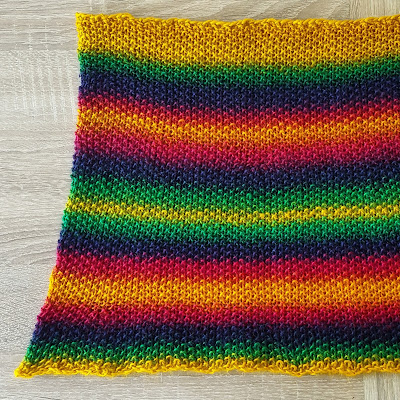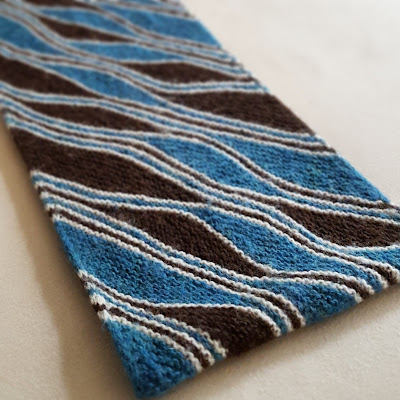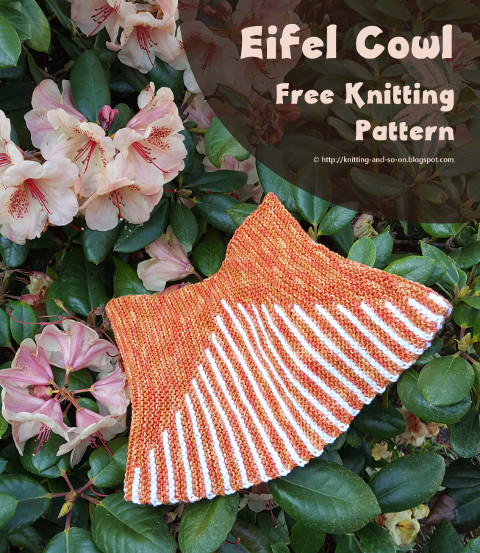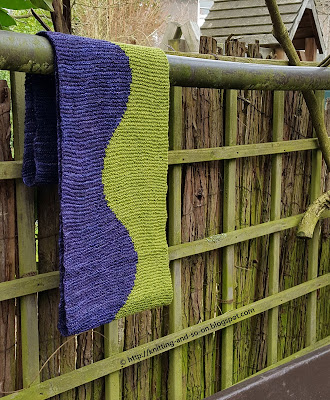I chose a light-weight merino yarn in different grey tones that - colors that are compatible with an office environment.
The piece is knitted flat - starting with a provisional cast on and knitted sideways with a combination of short row ribs and a lace pattern to make it interesting, and it is finished with Kitchener stitch.
Because of the short rows, this piece is wider at the bottom than at the top - so that it fits nicely around your shoulders. You can wear it either as a cowl or as a shoulder warmer / poncho.
Bartkauz is the german name for the Great Grey Owl. The color of the cowl reminded me of its plumage.

This work by Knitting and so on is licensed under a Creative Commons Attribution-NonCommercial-ShareAlike 4.0 International License.

Materials
- about 100 grams of lace weight yarn - I used Schachenmeyer Merino Extra Fine Lace (link to the yarn's Ravelry page)
- 3.75mm needles (straight or circular)
- scrap yarn and a crochet hook for provisional CO
- tapestry needle for grafting and to weave in ends
Techniques
- Provisional CO: My favorite method for a provision CO is the crochet provisional CO - it is shown in this Youtube video by New Stitch a Day.
- Shadow Wrap Short Rows: the last stitch you knit (or purl) before turning, is worked into the stitch in the row below (also called the "mother-stitch"), which also leaves you with a pair of stitches that has to be worked as one in the row above. This method is shown in this YouTube video by Lee Meredith.
- Grafting in stockinette stitch (also called Kitchener Stitch): a way to seamlessly join two rows of live stitches - as shown in this YouTube video by WEBS America's Yarn Store.
Gauge and Size
When knitting in garter stitch 12 stitches gave about 5 cm in width, and 11 garter stitch ridges (i.e. 22 rows) about 5 cm in height.
After blocking, the finished piece measures 40 cm in height. The circumference in 140 cm at the lower edge and 75 cm at the upper edge - however, the pattern is written in a way that the circumference can be adapted.
Lace Chart
If you prefer to knit lace from a chart, here's a chart for the lace pattern. The part within the red rectangles is one repeat of the lace pattern.
Row 2: p all
Row 3: k3, *k2tog, yo, yo, ssk repeat from * until 3 sts from end, k3
Row 4: p3 * p1, (k1, p1) into double yo, p1 repeat from * until 3 sts from end, p3
Row 5: k all
Row 6: p all
Row 7: k1, *k2tog, yo, yo, ssk repeat from * until 1 st from end, k1
Row 8: p1 * p1, (k1, p1) into double yo, p1 repeat from * until 1 st from end, p1
Instructions
Do a provisional CO of 90 sts
Setup Rows
Row 1: p all
Row 2: k all
Row 3: k all
Row 4: p all
Part A) Short Row Sequence
Ridge 1: p70, k into mother stitch and turn, k to end
Ridge 2: k60, p into mother stitch and p to end
Ridge 3: p50, k into mother stitch and turn, k to end
Ridge 4: k40, p into mother stitch and p to end
Ridge 5: p30, k into mother stitch and turn, k to end
Ridge 6: k20, p into mother stitch and p to end
Ridge 7: p10, k into mother stitch and turn, k to end
Ridge 8: k19, k into mother stitch and p to end
Ridge 9: p29, p into mother stitch and turn, k to end
Ridge 10: k39, k into mother stitch and p to end
Ridge 11: p49, p into mother stitch and turn, k to end
Ridge 12: k59, k into mother stitch and p to end
Ridge 13: p69, p into mother stitch and turn, k to end
Part B) Transition to Lace
Row 1: k all
Row 2: p all
Row 3: p all
Row 4: k all
Row 5: k all
Row 6: p all
Part C) Lace Pattern
Row 1: k all
Row 2: p all
Row 3: k3, *k2tog, yo, yo, ssk repeat from * until 3 sts from end, k3
Row 4: p3 * p1, (k1, p1) into double yo, p1 repeat from * until 3 sts from end, p3
Row 5: k all
Row 6: p all
Row 7: k1, *k2tog, yo, yo, ssk repeat from * until 1 st from end, k1
Row 8: p1 * p1, (k1, p1) into double yo, p1 repeat from * until 1 st from end, p1
Repeat rows 1 to 8 once more
Then knit rows 1 to 6 once.
Part D) Transition to Short Row Sequence
= Part B
Repeat Parts A to D six times more or until the lower edge nearly fits around your shoulders.
Then repeat parts A to C once more.
Graft in stockinette stitch.










































